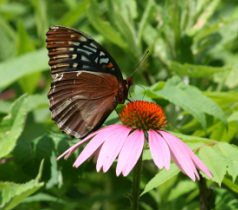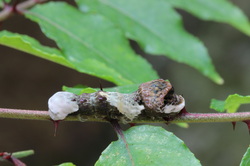Nectar Plants

Female Diana fritillary on purple coneflower
From Arkansas Butterflies and Moths gardening chapter:
One of the simplest ways to enjoy butterflies, aid in their conservation, and to simply feel good is to plant a butterfly garden. Type the key words “butterfly gardening” into an Internet search engine, and the results will be over 71 million websites. This staggering number reflects the passion unleashed for both butterflies and gardening during the past 20 years. Thousands of books, videos, and magazine articles have been written on the subject. One wonderful aspect of butterfly gardening is that additional wildlife will likely to be attracted to it. Just remember to enjoy your garden and subsequent butterflies as often as you work in it!
Creating and maintaining a carefully-planned garden is land management because all stages of butterflies and moths will benefit from the habitat provided. For those with only a deck or patio, never fear: a container garden filled with the right flowers will provide adequate adult resources. Butterfly gardens are only limited by imagination and resolve to make it happen.
Why do most butterflies visit flowers? They drink nectar that is contained inside a floral device called a nectary. Most flower nectar is about 20% sugar. Studies show that many butterflies prefer flowers with a thin, diluted nectar concentration that contains sugars of low molecular weight and nitrogen-rich amino acids. Nectar, animal droppings, carrion, tree sap, and rotten fruit all contain sugars and/or amino acids (the building blocks of proteins) and provide energy. Thin nectar prevents water loss from the butterfly’s body and prevents the proboscis from clogging. Bees, in contrast, appear to prefer thicker nectar that contains high molecular weight sugars.
Butterflies and wildflowers have a symbiotic relationship known as mutualism. Butterflies get nectar out of the bargain, and the flower is pollinated. Pollination is the process by which pollen (male gametophyte) from the male stamen of the flower is transferred to the sticky stigma on top of the female pistil. This is the first step in fertilizing the egg, which will eventually produce a seed. Each time a butterfly sips nectar from a flower, it gets covered in pollen. The pollen transfers from the butterfly to the stigma of the next flower. It thus it makes sense for the flower to “advertise” its nectar content and make itself look appealing to butterflies.
One of the simplest ways to enjoy butterflies, aid in their conservation, and to simply feel good is to plant a butterfly garden. Type the key words “butterfly gardening” into an Internet search engine, and the results will be over 71 million websites. This staggering number reflects the passion unleashed for both butterflies and gardening during the past 20 years. Thousands of books, videos, and magazine articles have been written on the subject. One wonderful aspect of butterfly gardening is that additional wildlife will likely to be attracted to it. Just remember to enjoy your garden and subsequent butterflies as often as you work in it!
Creating and maintaining a carefully-planned garden is land management because all stages of butterflies and moths will benefit from the habitat provided. For those with only a deck or patio, never fear: a container garden filled with the right flowers will provide adequate adult resources. Butterfly gardens are only limited by imagination and resolve to make it happen.
Why do most butterflies visit flowers? They drink nectar that is contained inside a floral device called a nectary. Most flower nectar is about 20% sugar. Studies show that many butterflies prefer flowers with a thin, diluted nectar concentration that contains sugars of low molecular weight and nitrogen-rich amino acids. Nectar, animal droppings, carrion, tree sap, and rotten fruit all contain sugars and/or amino acids (the building blocks of proteins) and provide energy. Thin nectar prevents water loss from the butterfly’s body and prevents the proboscis from clogging. Bees, in contrast, appear to prefer thicker nectar that contains high molecular weight sugars.
Butterflies and wildflowers have a symbiotic relationship known as mutualism. Butterflies get nectar out of the bargain, and the flower is pollinated. Pollination is the process by which pollen (male gametophyte) from the male stamen of the flower is transferred to the sticky stigma on top of the female pistil. This is the first step in fertilizing the egg, which will eventually produce a seed. Each time a butterfly sips nectar from a flower, it gets covered in pollen. The pollen transfers from the butterfly to the stigma of the next flower. It thus it makes sense for the flower to “advertise” its nectar content and make itself look appealing to butterflies.
Host Plants

Giant swallowtail on toothache tree
To keep butterflies and moths around your property year round, consider planting their host plants in at least a small area of your garden or yard. If you can tolerate voracious caterpillars chewing leaves and some flowers, you can revel in watching metamorphosis. Of course, pest species may invade. However, using a pesticide will wipe out not only the pest, but every other butterfly or moth (and a few other beneficial insects) that you do want in your garden. If the problem is limited to only a few caterpillars, just pick them off the plants.
Depending on the species, butterflies and moths overwinter in one of the four stages of the life cycle. A few spend the winter as adults, but most spend it as a chrysalis. A wood pile of stacked logs will provide a safe shelter for these butterflies, and is a more reliable option than purchasing a wooden butterfly house. If you use wood logs in a fireplace, check them for stowaways before you use them!
Depending on the species, butterflies and moths overwinter in one of the four stages of the life cycle. A few spend the winter as adults, but most spend it as a chrysalis. A wood pile of stacked logs will provide a safe shelter for these butterflies, and is a more reliable option than purchasing a wooden butterfly house. If you use wood logs in a fireplace, check them for stowaways before you use them!